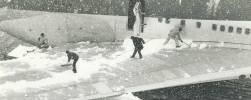For what it's worth, this is what Transport Canada (the Canadian version of the FAA) says about de-icing wings especially on small aircraft:
"Reducing the amount of deicing fluid used can have a positive impact on both the cost and the environmental. Manual methods of snow removal should be used whenever possible, as long as safety is not compromised. There are a wide variety of devices available to assist in the
removal of frozen contaminants from aircraft. Factors such as temperature, amount of contamination, wind conditions, and contaminant location must be taken into account when choosing the method.
Under extremely low temperatures, the use of glycol-based fluids is limited (refer to the fluid manufacturers’ specifications for details). In these circumstances, manual methods may be the only option."
Then it lists all the "manual" tools one can use to de-ice the wings, one of which is "scrapers".
The National Aviation Academy writes: "Manual deicing is deicing through mechanical movements like pushing or scraping. This method is great for smaller aircraft or if fluid is unavailable for use. The FAA recommends using brooms, brushes, wing/propeller covers, or air blowers during the manual deicing process. The manual process can be highly effective at removing residue, but mechanics should be careful not to brush ice or frost contamination into gaps or cavities of the aircraft."
AOPA writes: "For those of us at the bottom of a hangar waiting list, it can be disheartening to watch others taxi their clean aircraft out of their hangars while we're still scraping off ice or snow. Perhaps a fixed-base operator at your airport offers preheat and deice services that will clean your aircraft before you get to the airport. If not, stick a soft broom, towel, and deicers in your car before you head out. Simple non-abrasive tools
like a credit card can help remove snow and ice too."
But I can imagine that it would be a heck of a job here:



